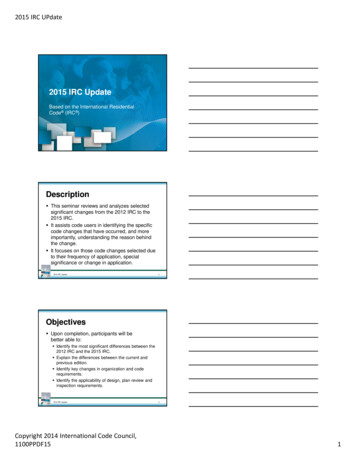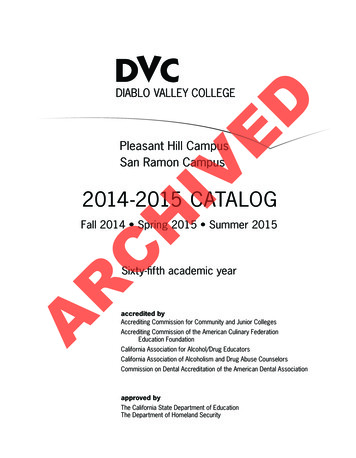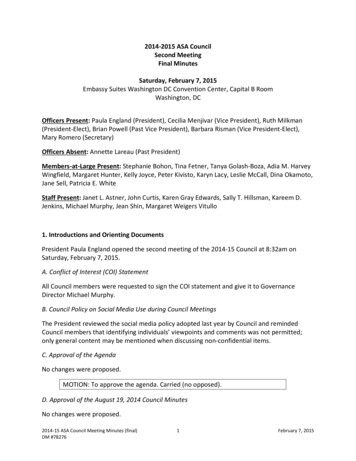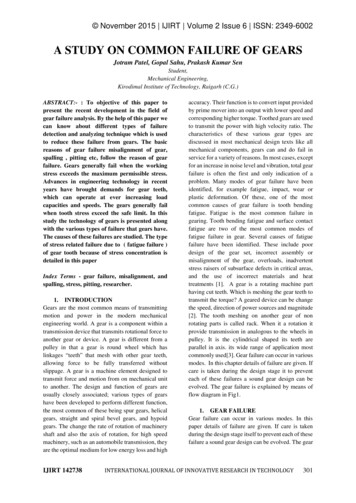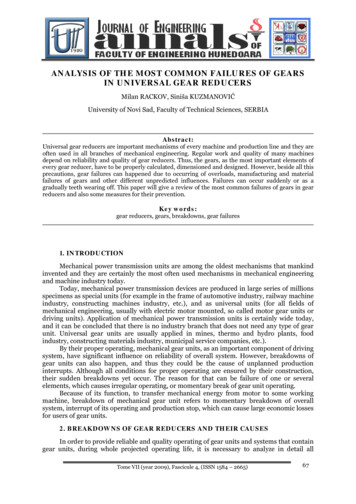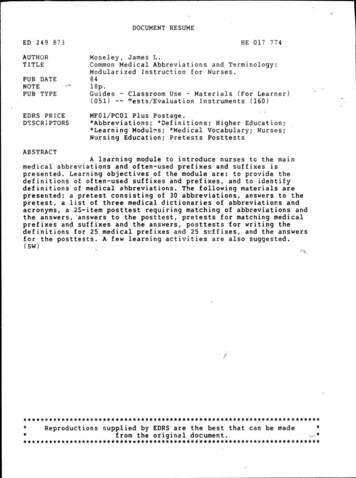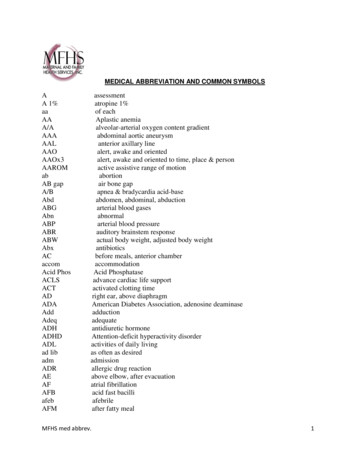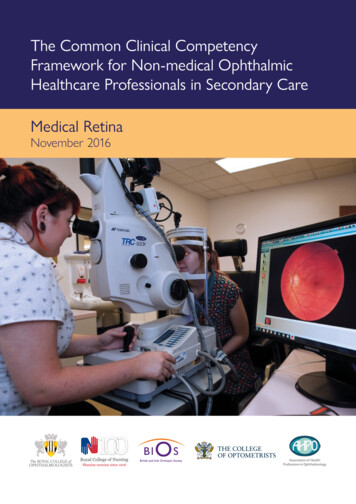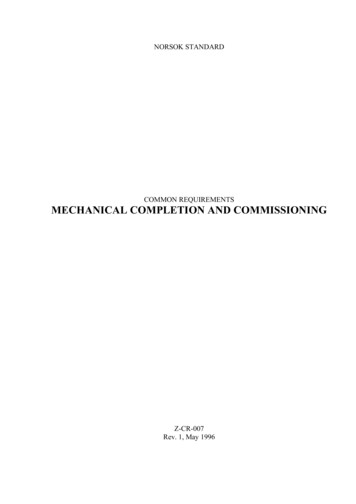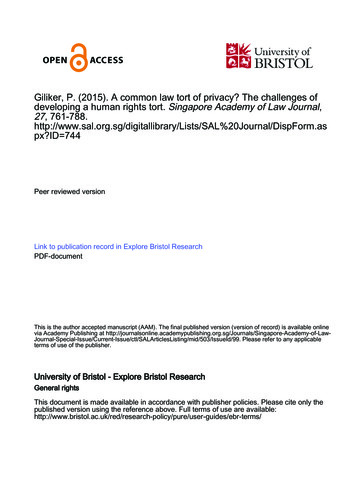
Transcription
Giliker, P. (2015). A common law tort of privacy? The challenges ofdeveloping a human rights tort. Singapore Academy of Law Journal,27, /SAL%20Journal/DispForm.aspx?ID 744Peer reviewed versionLink to publication record in Explore Bristol ResearchPDF-documentThis is the author accepted manuscript (AAM). The final published version (version of record) is available onlinevia Academy Publishing at ueId/99. Please refer to any applicableterms of use of the publisher.University of Bristol - Explore Bristol ResearchGeneral rightsThis document is made available in accordance with publisher policies. Please cite only thepublished version using the reference above. Full terms of use are licy/pure/user-guides/ebr-terms/
A COMMON LAW TORT OF PRIVACY?The challenges of developing a human rights tortPaula GILIKERProfessor of Comparative Law, University of Bristol.1The interests protected by the law of tort vary considerably in character, from injuryto the person to protection against wrongful harm to one’s reputation. Yet, as societyadvances and technology permits more and more intrusion into our personal lives, the meansby which harm may be perpetrated against an individual’s well-being continue to evolve.Canadian judge, Sharpe JA, commented recently that “[i]nternet and digital technology havebrought an enormous change in the way we communicate and in our capacity to capture, storeand retrieve information”,1 but that this must be balanced against the invasions they permitinto our personal lives which “cry out for a remedy”.2 Such concerns are, in fact, far fromnew. In the seminal article of Warren and Brandeis in 1890, the authors commented on thefact that “[i]nstantaneous photographs and newspaper enterprise have invaded the sacredprecincts of private and domestic life”.3 Winfield in 1931 further argued that the socialexigencies of the day justified the creation of a tort of invasion of personal privacy, either bythe courts or (failing that) the legislature.4 Winfield warned, however, of the dangers of a“sweeping” tort and of the need to identify with some precision a legal frameworkdetermining when liability would arise. He identified a number of difficulties which continueto this day. First, how to define a new tort which seeks to protect an interest as imprecise as“privacy”,5 which has been variably described as one protecting our dignity, autonomy orself-esteem,6 our right to identity, personal development and to establish and developrelationships with other human beings,7 or simply the “right to be let alone”?8 Penk andTobin correctly describe privacy as “multidimensional” in that it may be seen as a right, avalue, or a psychological state with links to human dignity and autonomy. 9 Secondly, how toprovide criteria such that the tort may be applied with some degree of certainty andpredictability? A third question also arises, however. In a modern liberal democracy, freedomof expression (and, in particular, freedom of the press) are perceived as values worthy ofprotection. On this basis, the right to freedom of expression is expressly recognised in anumber of constitutional instruments, for example, under the First Amendment to the US1Jones v Tsige 2012 ONCA 32; (2012) 108 OR (3d) 241 at [67], per Sharpe JA.Jones v Tsige 2012 ONCA 32; (2012) 108 OR (3d) 241 at [69], per Sharpe JA.3Samuel D Warren & Louis D Brandeis, “The Right to Privacy” (1890) 4 Harv L Rev 193 at 195.4P H Winfield, “Privacy” (1931) 47 LQR 23.5Many attempts have been made to define “privacy” with various degrees of success, see, notably, RuthGavison, ‘Privacy and the Limits of the Law” (1980) 89 Yale LJ 421; Nicole Moreham, “Privacy in theCommon Law: A Doctrinal and Theoretical Analysis” (2005) 121 LQR 628; Raymond Wacks, PersonalInformation: Privacy and the Law (Oxford: Clarendon Press, 1989); and Daniel J Solove, UnderstandingPrivacy (Cambridge: Harvard University Press, 2008).6See Campbell v MGN Ltd [2004] UKHL 22; [2004] 2 AC 457 at [51], per Lord Hoffmann, and Hosking vRunting [2004] NZCA 34; [2005] 1 NZLR1 at [239], per Tipping J.7Peck v UK (44647/98) (2003) 36 EHRR 41 at [57]; Pretty v UK (2002) 35 EHRR 1 at [61].8A phrase coined by Judge Cooley and famously cited in Samuel D Warren & Louis D Brandeis, “The Right toPrivacy” (1890) 4 Harv L Rev 193.9Stephen Penk & Rosemary Tobin, “The New Zealand Tort of Invasion of Privacy: Future Directions” (2011)19 TLJ 191. Wacks indeed argues that the search for a definition is sterile and futile in that privacy is a conceptso large that it threatens to devour itself: Raymond Wacks, “The Poverty of Privacy” (1980) 96 LQR 73 at 77.21
Constitution,10 Art 10 of the European Convention on Human Rights11 (“ECHR”), s 14 of theNew Zealand Bill of Rights Act 199012 (“Bill of Rights Act”), and s 2 of the CanadianCharter of Rights and Freedoms13 (“Canadian Charter”). The challenge, therefore, for amodern privacy tort is to reach an acceptable balance between protecting the right to privacyand that of the public to know. As seen in the tort of defamation, this inevitably gives rise todifficult value judgments with which both politicians and judges may be reluctant to becomeopenly involved.142In focusing on a particular evolution in the law of tort – the creation of new tortswhich seek to protect victims against wrongful invasions into their private lives – this articlewill examine the challenges this has presented to the traditional tort law framework. It willconsider three common law jurisdictions where the courts have recently acknowledged tosome extent a tort (or torts) protecting privacy rights: England and Wales, New Zealand andthe Canadian province of Ontario. These are also jurisdictions in which rights-basedinstruments such as the ECHR, the Bill of Rights Act, the International Covenant on Civiland Political Rights,15 the United Nations Convention on the Rights of the Child16 and theCanadian Charter have influenced the shape of these new forms of tort law. In criticallyanalysing recent developments, this article will consider how the courts have responded to thechallenges of integrating human rights principles into the private law of tort and whether thecurrent legal position indicates that, despite the reluctance of politicians to intervene, this isan area of law in which legislative intervention is not only desirable, but necessary.I.A TORT OF PRIVACY? THE RESPONSE OF ENGLAND AND WALES.3Despite the introduction of the UK Human Rights Act 199817 (“the 1998 Act”), thecourts of England and Wales have continued to reject the creation of a general tort ofinvasion of privacy. Lord Hoffmann in Wainwright v Home Office18 was of the view that anyperceived gaps in the law could (and should) be filled by judicious development of existingcauses of action such as breach of confidence or, following the introduction of the 1998 Act,10“Congress shall make no law . abridging the freedom of speech, or of the press.”Convention for the Protection of Human Rights and Fundamental Freedoms (Eur TS No 5; 213 UNTS 221;1953 UKTS No 71) (4 November 1950; entry into force 3 September 1953) Art 10.1: “Everyone has the right tofreedom of expression. This right shall include freedom to hold opinions and to receive and impart informationand ideas without interference by public authority and regardless of frontiers.”121990 No 109. “Everyone has the right to freedom of expression, including the freedom to seek, receive, andimpart information and opinions of any kind in any form.”13Constitution Act 1982 (Canada) Pt I. See s 2 – Fundamental Freedoms:Everyone has the following fundamental freedoms:(a) freedom of conscience and religion;(b) freedom of thought, belief, opinion and expression, including freedom of the press and other mediaof communication;(c) freedom of peaceful assembly; and(d) freedom of association.14See, for example, Flood v Times Newspapers Ltd [2012] UKSC 11; [2012] 2 AC 273 (revelation of potentialpolice corruption) and the privacy case of AAA v Associated Newspapers Ltd [2013] EWCA Civ 554(revelations of possible paternity of child deemed to give rise to a “difficult and sensitive balancing exercise”: at[45]).1516 December 1966; entry into force 23 March 1976.1620 November 1989; entry into force 2 September 1990.17c 42.18[2003] UKHL 53; [2004] 2 AC 406.112
with claims under the Act for breach of Art 8 of the ECHR (right to a private life).19 Therewas, in his view, no need to “distort” the principles of the common law.20 In so doing, theHouse of Lords rejected any analogy with developments in US law and tellingly quoted fromSir Robert Megarry V-C in Malone v Metropolitan Police Commissioner:21 “[I]t is nofunction of the courts to legislate in a new field. The extension of the existing laws andprinciples is one thing, the creation of an altogether new right is another.”224The House of Lords in Campbell v Mirror Group Newspapers Ltd23 (“Campbell”) in2004 confirmed that the approach taken by English law would be to acknowledge that,following the 1998 Act, there has been a “shift in the centre of gravity” of the action forbreach of confidence.24 No new tort would be created, but the action for breach of confidencewould be extended to include not only the divulgence of confidential information but also theunjustified publication of private information: in this case, a series of articles andphotographs of supermodel Naomi Campbell detailing and showing her attendance atmeetings of Narcotics Anonymous. In so doing, the House of Lords accepted that an actioncould be brought even where there was no pre-existing relationship of confidence betweenthe individual and the party obtaining the information.25 This was, however, more than amere extension of an existing cause of action. In OBG Ltd v Allan,26 Lord Nichollsrecognised that two versions of breach of confidence now existed: the traditional actionprotecting secret/confidential information; and the new action which sought to protect adifferent interest: that of privacy.275The court also took a further step in Campbell. Influenced by the argument that thecourt as a “public authority” under s 6(3) of the 1998 Act should seek to develop private lawin a convention-compatible way,28 this new action was found to have absorbed the rightsprotected by Arts 8 and 10 of the ECHR.29 Buxton LJ in the later case of McKennitt v Ash30(“McKennitt”) declared that to find the rules of what he termed the new “tort of breach of19Sections 6 and 7 of the UK Human Rights Act 1998 (c 42) provide for civil claims against public authoritiesfor failing to act in compliance with Convention rights.20Wainwright v Home Office [2003] UKHL 53; [2004] 2 AC 406 at [52]. Lord Hoffmann was also of the view(at [51]) that it was not clear that Art 8 of the Convention for the Protection of Human Rights and FundamentalFreedoms (Eur TS No 5; 213 UNTS 221; 1953 UKTS No 71) (4 November 1950; entry into force 3 September1953) had been breached in this case, but a subsequent appeal to the European Court of Human Rights foundotherwise: Wainwright v United Kingdom (12350/04) (2007) 44 EHRR 40.21[1979] Ch 344.22Malone v Metropolitan Police Commissioner [1979] Ch 344 at 372.23[2004] UKHL 22; [2004] 2 AC 457. This built on earlier decisions such as Douglas v Hello! Ltd (No 1)[2001] QB 967 and A v B plc [2002] EWCA Civ 337; [2003] QB 195.24Campbell v Mirror Group Newspapers Ltd [2004] UKHL 22; [2004] 2 AC 457 at [51].25This is a key requirement under the traditional action for breach of confidence: the information in questionmust have the necessary quality of confidence about it, the information must be imparted in circumstancesimporting an obligation of confidence, and there must be an unauthorised use or disclosure of that information:see Coco v AN Clark (Engineers) Ltd [1969] RPC 41 at 47, per Megarry J.26[2007] UKHL 21; [2008] 1 AC 1.27OBG Ltd v Allan [2007] UKHL 21; [2008] 1 AC 1 at [255].28For a debate as to the extent of this obligation on the court, see Gavin Phillipson, “Transforming Breach ofConfidence? Towards a Common Law Right of Privacy under the Human Rights Act” (2003) 66 MLR 726 andMurray Hunt, “The ‘Horizontal Effect’ of the Human Rights Act” [1998] PL 423 (which argues for strongindirect horizontal effect).29Campbell v Mirror Group Newspapers Ltd [2004] UKHL 22; [2004] 2 AC 457 at [17].30[2006] EWCA Civ 1714; [2008] QB 73.3
confidence”, the courts should look in the jurisprudence of these articles which were notmerely of persuasive or parallel effect but provided the very content of the domestic tort thatthe English court had to enforce.316From these cases, a new methodology can be identified whereby liability isdetermined by asking two questions:(a)Is there a reasonable expectation of privacy? This will be shown if theinformation is private in the sense that it is protected by Art 8 of the ECHR.(b)Where Art 8 is engaged, is interference with this right justified in all thecircumstances by Art 10 of the ECHR (freedom of expression)?32In determining whether a reasonable expectation of privacy exists, a number of factors maybe relevant, for example, the attributes of the claimant; the nature of the activity in which theclaimant was engaged; the place at which it was happening; the nature and purpose of theintrusion; the absence of consent and whether it was known, or could be inferred; and theeffect on the claimant and the circumstances in which (and the purposes for which) theinformation came into the hands of the publisher.33 The court will take account of all thecircumstances of the case and, indeed, in many cases, the information in question may beobviously private, for example, information relating to health (as in Campbell), personalrelationships (as in McKennitt)
A COMMON LAW TORT OF PRIVACY? The challenges of developing a human rights tort Paula GILIKER Professor of Comparative Law, University of Bristol. 1 The interests protected by the law of tort vary considerably in character, from injury to the person to protection against wrongful harm to one’s reputation. Yet, as society



